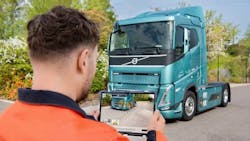Volvo Group Develops Augmented Reality App
This new app from Volvo Group—designed to aid crews responding to emergencies involving Volvo’s electric trucks—may seem outside the usual real of Automation World coverage, but it highlights how useful the technology can be in terms of delivering immediate information to operations and maintenance personnel in both critical and routine manufacturing operations.
Model simplification algorithms reduce 16 million polygons (CAD lines converted into 2D or 3D shapes) in the software to about 200,000 polygons so that the app can be used on mobile devices.
According to the Volvo Group, it is the first truck manufacturer to launch an augmented reality (AR) safety app for electric trucks. Volvo says the app is developed to “deliver instant, valuable information from the electric truck to the emergency services team arriving on the scene to guide them in real-time and ensure safe rescue conditions.”
Having this information readily available is critical in an emergency response situation due to the high-voltage systems used to power heavy electric trucks. The potential for harm to responders is not unlike the potential harm faced by operations and maintenance personnel in industrial environments—thus the transferrable value inherent in Volvo’s app for use in industry.
The app was developed by a team of experts at Volvo Group’s Research & Development facilities in Sweden, France and the United States and combines connectivity, cameras, sensors, 3D modeling and AR overlays. Volvo says its safety app provides a detailed view of the vehicle, with information on the location of high-voltage cables, battery packs and other key components. It also provides step-by-step instructions on how to safely shut down the electric vehicle’s power supply. Specific safety documentation related to the electric truck is also accessible via the app.
“The safety app has been tested in a variety of real-world scenarios and has received positive feedback from first responders who have tried it in the field,” said Vincent Barnoux, business solution engineer at Volvo Group.
Digital twin use in the app
In his presentation at PTC’s LiveWorx 2023 event, Barnoux said enabling this app to work for every Volvo electric truck (of which there are about 1500 across the company’s Renault, Volvo and Mack brands), the company accessed the digital twins of each vehicle. “It was a two-year process from building the digital twins using CAD data to using those data for the app,” he said.
Alluding to use of the app beyond first responders, Barnoux said the app can also be used for training so that users can see all components in the trucks. “For example, the blinking cable in the AR view directs the user to the exact cable to work on,” he said.
Simplifying the data for mobile use
Barnoux said Volvo used PTC’s Vuforia library to understand how AR works and make the app easy to use.
Barnoux said Volvo is now looking to adapt this app for use in Volvo service areas. For that, the app will need more detailed digital twin data and advanced diagnostics information. “We have more than 15,000 service points and about 100,000 service technicians,” he explained, “so we’re focusing now on finding out what service technicians need to develop the most effective AR app for them. We want this app to be integrated [with the service technicians’ workflow] so technicians don’t have to jump between different systems when working. We’re working with PTC on that now.”
About the Author
David Greenfield, editor in chief
Editor in Chief

Leaders relevant to this article:


